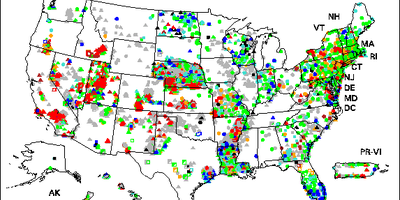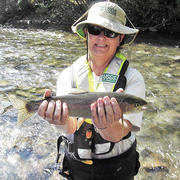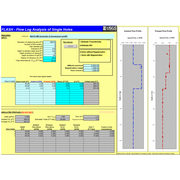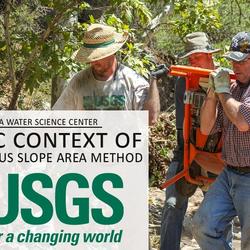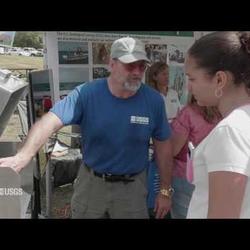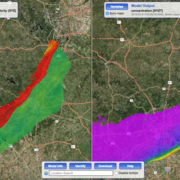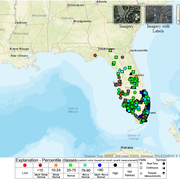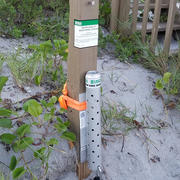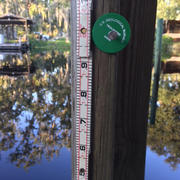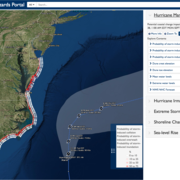Due to a lapse in appropriations, the majority of USGS websites may not be up to date and may not reflect current conditions. Websites displaying real-time data, such as Earthquake and Water and information needed for public health and safety will be updated with limited support. Additionally, USGS will not be able to respond to inquiries until appropriations are enacted. For more information, please see www.doi.gov/shutdown
Groundwater and Streamflow Information Program
Home
Programs L2 Landing Page
The Groundwater and Streamflow Information Program (GWSIP) serves as the national source of impartial, timely, rigorous and relevant data for short- and long-term water decisions by local, State, Tribal, regional and national stakeholders. Discover a wealth of hydrologic data, maps, graphs, and other resources!
Next Generation Water Observing System: Delaware River Basin
The USGS next-generation water observing system will provide high-fidelity, real-time data on water quantity and quality necessary to support modern water prediction and decision support systems for water emergencies and daily water operations. The Delaware River Basin pilot provides an opportunity to develop the NextGen observing system in a nationally important, complex interstate river...
Wood River Valley Aquatic Biology and Habitat Assessment
Blaine County’s population nearly quadrupled from about 5,700 to 22,000 people between 1970 and 2010. Residents and resource managers of the Wood River Valley of south-central Idaho are concerned about the potential effects that population growth and the expected increased demand for water might have on the quantity and quality of the valley’s ground and surface waters. Increased water use has...
Groundwater, Aquifers, and Wells
Science to discover and describe the location, condition, and behavior of water in the ground.
Regional Groundwater Studies
These assessments will document the effects of human activities on water levels, groundwater storage, and discharge to streams and other surface-water bodies; explore climate variability impacts on the regional water budget; and evaluate the adequacy of data networks to assess impacts at a regional scale.
Stable Streamgaging Network
At the core of NSIP will be a set of USGS-funded streamgages strategically positioned across the country that are continuously operated to fulfill five Federal needs for streamflow information. These will be a permanent set of core streamgages from which streamflow information would be delivered in real time, uncompromised by changing support from funding partners.
Groundwater Level Data
Measurements of groundwater levels from wells are used to monitor changes in groundwater conditions due to climate variability and withdrawals (pumping). The GWRP has supported the development of a Groundwater Climate-Response Network, a network of wells selected to illustrate the response of the groundwater system to climate variations nationwide.
Geophysical Methods & Applications
USGS conducts research into new and emerging geophysical methods and applications for groundwater investigations. Near-surface geophysical techniques can be used to rapidly and effectively characterize the shallow subsurface and to monitor hydrologic and remediation processes in ways not previously possible with standard technology.
Hurricane Irma's Water Footprint
Hurricane Irma, the most intense hurricane observed in the Atlantic in the last decade, approached the west coast of Florida on September 10th, 2017. This animation shows the precipitation and river conditions through time as Irma moved over the southeastern United States.
Hurricane Harvey's Water Footprint
Active visualization of Hurricane Harvey's water footprint as it approached the Texas coast (Aug 25 - Aug 30, 2017)
WaterWatch Flood Map
Current stream conditions and NWS forecast stream conditions.
Time series of high-resolution images enhances efforts to monitor post-fire condition and recovery, Waldo Canyon fire, Colorado, USA
Interpretations of post-fire condition and rates of vegetation recovery can influence management priorities, actions and perception of latent risks from landslides and floods. In this study, we used the Waldo Canyon fire (2012, Colorado Springs, Colorado, USA) as a case study to explore how a time series (2011–2016) of high-resolution images can...
Vanderhoof, Melanie; Burt, Clifton; Hawbaker, Todd J.Efficient delineation of nested depression hierarchy in digital elevation models for hydrological analysis using level-set method
In terrain analysis and hydrological modeling, surface depressions (or sinks) in a digital elevation model (DEM) are commonly treated as artifacts and thus filled and removed to create a depressionless DEM. Various algorithms have been developed to identify and fill depressions in DEMs during the past decades. However, few studies have attempted...
Wu, Qiusheng; Lane, Charles R.; Wang, Lei; Vanderhoof, Melanie; Christensen, Jay R.; Liu, HongxingGlobal Modern Charcoal Dataset (GMCD): A tool for exploring proxy-fire linkages and spatial patterns of biomass burning
Progresses in reconstructing Earth's history of biomass burning has motivated the development of a modern charcoal dataset covering the last decades through a community-based initiative called the Global Modern Charcoal Dataset (GMCD). As the frequency, intensity and spatial scale of fires are predicted to increase regionally...
Hawthorne, Donna; Courtney Mustaphi, Colin J.; Aleman, Julie C.; Blarquez, Olivier; Colombaroli, Daniele; Daniau, Anne-Laure; Marlon, Jennifer R.; Power, Mitchell; Vanniere, Boris; Han, Youngming; Hantson, Stijn; Kehrwald, Natalie M.; Magi, Brian I.; Yue, Xu; Carcaillet, Christopher; Marchant, Rob; Ogunkoya, Ayodele; Githumbi, Esther N.; Muriuki, Rebecca M.DOI/GTN-P climate and active-layer data acquired in the National Petroleum Reserve–Alaska and the Arctic National Wildlife Refuge, 1998–2016
This report provides data collected by the climate monitoringarray of the U.S. Department of the Interior on Federallands in Arctic Alaska over the period August 1998 to July2016; this array is part of the Global Terrestrial Network forPermafrost (DOI/GTN-P). In addition to presenting data, thisreport also describes monitoring, data collection,...
Urban, Frank E.; Clow, Gary D.Lake sediment fecal and biomass burning biomarkers provide direct evidence for prehistoric human-lit fires in New Zealand
Deforestation associated with the initial settlement of New Zealand is a dramatic example of how humans can alter landscapes through fire. However, evidence linking early human presence and land-cover change is inferential in most continental sites. We employed a multi-proxy approach to reconstruct anthropogenic land use in New Zealand’s South...
Argiriadis, Elena; Battistel, Dario; McWethy, David B.; Vecchiato, Marco; Kirchgeorg, Torben; Kehrwald, Natalie M.; Whitlock, Cathy; Wilmshurst, Janet M.; Barbante, CarloGeologic framework and hydrogeology of the Rio Rico and Nogales 7.5’ quadrangles, upper Santa Cruz Basin, Arizona, with three-dimensional hydrogeologic model
Rapid population growth and declining annual recharge to aquifers in the upper Santa Cruz Basin area of southern Arizona, have increased the demand for additional groundwater resources. This demand is predicted to escalate in the future because of higher temperatures, longer droughts, less aquifer recharge, and decreased river and stream base flow...
Page, William R.; Bultman, Mark W.; VanSistine, D. Paco; Menges, Christopher M.; Gray, Floyd; Pantea, Michael P.Pliocene erosional pulse and glacier-landscape feedbacks in the western Alaska Range
Pliocene–Pleistocene glaciation modified the topography and erosion of most middle- and high-latitude mountain belts, because the evolution of catchment topography controls long-term glacier mass balance and erosion. Hence, characterizing how erosion rates change during repeated glaciations can help test hypothesized glacier erosion-landscape...
Lease, Richard O.Lake levels in a discontinuous permafrost landscape: Late Holocene variations inferred from sediment oxygen isotopes, Yukon Flats, Alaska
During recent decades, lake levels in the Yukon Flats region of interior Alaska have fluctuated dramatically. However, prior to recorded observations, no data are available to indicate if similar or more extreme variations occurred during past centuries and millennia. This study explores the history of Yukon Flats lake origins and lake levels for...
Anderson, Lesleigh; Finney, Bruce P.; Shapley, Mark D.Improving understanding of soil organic matter dynamics by triangulating theories, measurements, and models
Soil organic matter (SOM) turnover increasingly is conceptualized as a tension between accessibility to microorganisms and protection from decomposition via physical and chemical association with minerals in emerging soil biogeochemical theory. Yet, these components are missing from the original mathematical models of belowground carbon dynamics...
Blankinship, Joseph C.; Crow, Susan E.; Berhe, Asmeret Asefaw; Druhan, Jennifer L.; Heckman, Katherine A.; Keiluweit, Marco; Lawrence, Corey R.; Marin-Spiotta, Erika; Plante, Alain F.; Rasmussen, Craig; Schadel, Christina; Schmiel, Joshua P.; Sierra, Carlos A.; Thomson, Aaron; Wagai, Rota; Weider, William R.Refinement of a regression-based method for prediction of flow-duration curves of daily streamflow in the conterminous United States
Regional regression is a common tool used to estimate daily flow-duration curves (FDCs) at ungaged locations. In this report, several refinements to a particular implementation of the regional regression method for estimating FDCs are evaluated by consideration of different methodological options through a leave-one-out cross-validation procedure...
Over, Thomas M.; Farmer, William H.; Russell, Amy M.Applying high-resolution imagery to evaluate restoration-induced changes in stream condition, Missouri River Headwaters Basin, Montana
Degradation of streams and associated riparian habitat across the Missouri River Headwaters Basin has motivated several stream restoration projects across the watershed. Many of these projects install a series of beaver dam analogues (BDAs) to aggrade incised streams, elevate local water tables, and create natural surface water storage by...
Vanderhoof, Melanie; Burt, CliftonQuantifying the visual-sensory landscape qualities that contribute to cultural ecosystem services using social media and LiDAR
Landscapes are increasingly recognized for providing valuable cultural ecosystem services with numer- ous non-material benefits by serving as places of rest, relaxation, and inspiration that ultimately improve overall mental health and physical well-being. Maintaining and enhancing these valuable benefits through targeted management and...
Van Berkel, Derek B.; Tabrizian, Payam; Dorning, Monica; Smart, Lindsey S.; Newcomb, Doug; Mehaffey, Megan; Neale, Anne; Meentemeyer, Ross K.Modeling and Software
Hydrologic modeling and analysis tools are important components of NAWQA studies. The types of modeling and analysis tools that play a large role in NAWQA include: Statistical models and analyses, Geographic information system (GIS) analyses, Process-based models, and Hybrid statistical, GIS, and process-based models.
FLASH: A Computer Program for Flow-Log Analysis of Single Holes
FLASH (Flow-Log Analysis of Single Holes) is a computer program for the analysis of borehole vertical flow logs.
USGS Storm-Tide Sensor for Hurricane Florence
A USGS storm-tide sensor, deployed in advance of Hurricane Florence's landfall. The sensors are housed in vented steel pipes a few inches wide and about a foot long. They are being installed on bridges, piers, and other structures that have a good chance of surviving the storm.
The information the sensors collect will help define the depth and duration of a storm
...USGS Hurricane Preparedness
Before a hurricane, USGS Scientists undertake a data collection effort of a grand scale. They install a temporary mobile network of sensors along the coasts to collect additional data on the intensity of storm surge, one of the most dangerous elements of a hurricane. This effort provides critical information that allows various USGS partners and emergency responders to
...Historic Context of the Continuous Slope Area Method
The Arizona Water Science Center details the history and development of the Continuous Slope-Area Method. Learn about the people and events that began these new advances in the field of stream gaging.
Music Artist: Glenn Jones, “Bergen County Farewell”. CC License. Music provided by www.FreeMusicArchive.com
...Reach-Scale Monitoring | Advances in Stream Gaging
The Arizona Water Science Center demonstrates new methods in Reach-Scale Monitoring to improve accuracy and measurability of high flow events. By installing pressure transducers and using LiDAR to measure topography data, hydrologists are able to simulate flows with two dimensional models which will help better calibrate stream gages. These advances have potential to aid
...USGS Supports Broward Water Matters Day 2017
Caribbean-Florida Water Science Center, Davie Office, supported Broward County Watter Matters Day on March 11, 2017 as part of an outreach event to the public.
http://www.broward.org/WaterMatters/Pages/ProgramsWMD.aspx
Establishing a Permanent Measuring Point and Reference Marks at a Well
This video demonstrates how to establish permanent reference points and markers at a well site.
Measuring Total Well Depth Using a Steel Tape - YouTube
This video demonstrates how to measure total well depth below land surface using a weighted, graduated steel tape.
Historic USGS Streamgage on the Wabash River at Lafayette Indiana
This video will provide a brief history and purpose for one of the oldest streamgages in Indiana. The gage is at the Wabash River at Lafayette, Indiana. The site number is 03335500. This video was produced at the request of the West Lafayette Parks Department where this historic gage is located. A QR code is displayed on an interpretive plaque next to the gage which is
...Rio Brazos near Tierra Amarilla, NM
Hydrologic technician Lindsay Hastings took this photo of the Rio Brazos near Tierra Amarilla, New Mexico during her first field trip as a streamgager with the New Mexico Water Science Center. Did you know that New Mexico was the birth place of streamgaging? The USGS began collecting streamflow information in 1889 when the first streamgage was established on the Rio Grande
...Spring sampling in Wyoming
Spring sampling location along Little Sandy River in southern Wyoming. Groundwater discharge that flows into the Upper Colorado River Basin varies in response to drought, which is likely due to aquifer systems that contain relatively young groundwater, according to a new U.S. Geological Survey study
...USGS scientist collects noble gas sample from spring site
USGS scientist collects noble gas sample from spring site near Roaring Judy, Colorado. Groundwater discharge that flows into the Upper Colorado River Basin varies in response to drought, which is likely due to aquifer systems that contain relatively young groundwater, according to a new U.S. Geological
...Water quality and sampling at spring site
Water quality and sampling equipment deployed at spring site near Roaring Judy, Colorado. Groundwater discharge that flows into the Upper Colorado River Basin varies in response to drought, which is likely due to aquifer systems that contain relatively young groundwater, according to a new U.S. Geological
...USGS Working to Restore Streamgages
For questions about a streamgage in your state, please contact your local USGS water science center; contacts can be found at https://water.usgs.gov/key_officials.html.
USGS Keeps Vital Information Flowing in Carolina Flood Catastrophe
To learn more about USGS’ role providing science to decision makers before, during and after #Florence, visit the #USGS Hurricane Florence page at https://www.usgs.gov/florence
Media Advisory: Witness Groundbreaking River Measurements Collected from the Sky
This Thursday, scientists with the U.S. Geological Survey and NASA will test new technologies near Parkdale, Colorado, located west of Cañon City, to better understand how unmanned aerial systems (UAS), or drones, may be used to measure water depth, water levels and velocity from the sky.
USGS Hurricane Response Met Challenges in 2017, Prepares for 2018
No one has a crystal ball to foresee what will happen during the 2018 hurricane season that begins June 1, but NOAA forecasters say there’s a 75 percent chance this hurricane season will be at least as busy as a normal year, or busier.
USGS Releases New Web-Based Groundwater Model Visualization Tool
A new U.S. Geological Survey groundwater model visualization tool is now available to help users visualize the inputs and outputs of complex groundwater models across the country.
USGS Flood Experts Respond to High Water in Central, Northeastern U.S.
Crews from the U.S. Geological Survey have been in the field for weeks measuring flooding in the Midwest and in the Mississippi River watershed, and more recently flooding and storm tides on the Northern Atlantic coast, as higher temperatures, heavy rain, snowmelt and nor’easters affected numerous states.
Alaska Earthquake Rattles Florida’s Groundwater Plumbing
At 12:32 am Alaska time on January 23, 2018, a magnitude 7.9 earthquake shook Alaska residents out of their beds and set off fears of a tsunami all down the West Coast. Fortunately, the tsunami was only a few inches in height, but within an hour of the earthquake in Alaska, waves of a different sort were hitting far away in Florida.
USGS Installs Storm-Tide Sensors Along Gulf Coast for Hurricane Nate
To learn more about USGS’ role providing science to decision makers before, during and after Hurricane Nate, visit the USGS Hurricane Nate page at https://www.usgs.gov/nate.
New Report on Channel Bed Erosion Helps Assess Bridge Stability in St. Louis
A new assessment of channel bed erosion near 13 highway bridges in the greater St. Louis, Missouri, area is now available in an online report from the U.S. Geological Survey, produced in cooperation with the Missouri Department of Transportation.
USGS Crews Are in the Field Documenting the Extent of Flooding from Hurricane Irma
Reporters: Do you want to accompany a USGS field crew as they work in the field to document how high the flood waters and storm surge from Hurricane Irma reached around the Jacksonville, Tampa and Fort Myers Areas?
If so, please contact Jeanne Robbins, jrobbins@usgs.gov, 919-571-4017.
Hurricane Maria expected to alter North Carolina, Virginia and Maryland Beaches
To learn more about USGS’ role providing science to decision makers before, during and after Hurricane Maria, visit the USGS Hurricane Maria page at https://www.usgs.gov/maria.
USGS Tidal Network Monitoring Elevated Water Levels Off Hampton Roads
To learn more about USGS’ role providing science to decision makers before, during and after Hurricane Jose, visit the USGS Hurricane Jose page at https://www.usgs.gov/jose.



